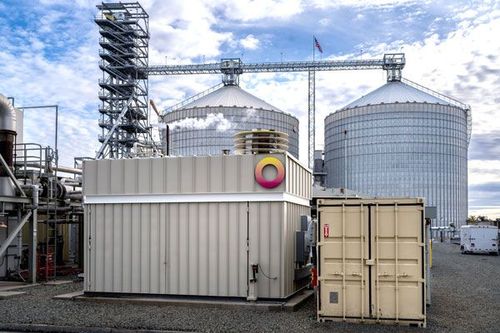Bringing Heat

Rondo Energy can help ethanol producers drastically decarbonize their plants with an innovative technology that uses a well-understood material: ceramic bricks. Jeremy Keller, senior vice president of business development and head of sales with Rondo, explains that the Alameda, California, company views its technology as “an engineering project, not a science project.”
The cofounders of the Bay Area startup, John O’Donnell and Pete von Behrens, worked in the solar energy sector for 15 years, developing solar power for industrial heat. They realized that solar power’s intermittent energy production needed to be converted into a consistent output of energy. “The key thing with being able to scale and deliver commercial technology is trying to do as little that’s novel as possible,” Keller says. “The system really is pulling together tried-and-true materials into a new solution that is innovative in how it’s packaged, but not innovative in any of its fundamental material science.”
The well-understood materials in Rondo’s technology are ceramic bricks that have been used for thermal energy storage and steam blast furnaces for two centuries. Each brick can store as much energy as the battery system in a Tesla Model 3. The bricks are stacked together in an insulated chamber and heated to high temperatures using renewable electricity from wind or solar. The energy is stored in the bricks as heat, then air is blown across the bricks to a boiler, where it creates steam. The steam can then be used for heat as well as electricity via a steam turbine. Keller explains that this serves as a drop-in option for ethanol plants to replace their existing steam generation process—“a full replacement for a natural gas boiler.”
The materials used in Rondo’s heat batteries are “off-the-shelf” components, keeping the price reasonable for buyers, five-times cheaper than lithium ion batteries. “Our boiler [is essentially] the same boiler that’s used in a cogeneration gas turbine system. So, we’re not doing anything interesting on the boiler,” Keller says, explaining that the system uses standard industrial refractory insulation. “[It’s] really just about pulling all of that together into a package that is low-cost, reliable and safe.”
Plant Integration
The use of heat batteries should improve ethanol plant efficiency, as most natural gas boilers are only 80 to 85 percent efficient. Rondo’s system, on the other hand, is 98 percent efficient in steam production and 96 percent efficient when used for both steam and electricity generation, the latter losing a couple percentage points due to the turbine. “It’s really very efficient,” Keller says. “And the real value is that we’re taking this intermittent electricity source [and] converting it into a very highly dispatchable and reliable resource—” Renewable energy is a more viable option for decarbonization than a decade ago, as prices have dropped 90 percent in the last ten years.
The energy output of Rondo’s RHB300 battery is designed to be competitive with a natural gas boiler. To convert over to heat batteries, an ethanol producer would need the same number of RHB300s as conventionally sized boilers currently in use.
The carbon intensity (CI) score reduction of these added efficiencies—on top of a renewable energy source—is significant, Keller says. Conversion from natural gas boilers over to heat batteries can reduce an ethanol producer’s CI score by 22 to 23 points. The area needed for these heat batteries is about the size of a typical ethanol plant’s boiler area.
The first commercial installation of Rondo’s technology is a small demonstration unit integrated into Calgren Renewable Fuels’ biorefinery in Pixley, California. Installed in March 2023, the demonstration unit has proven to be a good investment. “We really like the idea of storing excess wind or solar energy in a thermal battery; we think that’s just perfect for ethanol plants,” says former Calgren CEO Lyle Schlyer, who is currently in the process of retiring.
The integration of the demonstration-size heat battery into Calgren’s system was efficient, with no major production time lost. “For Calgren, we were able to install that system with no downtime for the ethanol plant,” Keller says. “For these projects, it’s going to be very similar in that we can do all of our construction work and testing with very minimal interruption to the ethanol plants.”
The Pixley plant produces some energy onsite and sells some of it to Rondo in place of what would be renewable energy, which is then run through the heat battery and returned to the plant as thermal energy. “The easiest way to integrate that small unit was to heat boiler feed water, so that’s what we’re doing,” Schlyer says. This easy-to-measure setup allows Calgren and Rondo to confirm that the process works properly. Schlyer explains that Calgren plans to move forward with installing full-size units in the future, potentially at both the Pixley biorefinery and its sister plant in Kansas, Pratt Energy LLC.
Renewable Sources
Rondo’s batteries don’t necessarily need renewable energy, but coupling thermal energy storage with wind or solar maximizes the carbon reduction potential of the technology. At some sites, producers may need to build infrastructure to power the heat battery. A 100 MMgy ethanol plant with 8 to 12 megawatts of power load and 200 pounds of steam per hour would need to build 140 to 200 megawatts of solar or wind, Keller explains. The amount of energy production infrastructure would be on the higher end for solar and the lower end for wind. Building this scale of energy production can be a challenge due to permitting and community concerns.
However, Keller explains that many plants in the windy Midwest may be able to take advantage of curtailment to access renewable energy instead of building their own energy production. Curtailment is the practice of shutting down electricity production for a period when production is too high. “When it’s really windy, it’s windy across broad swaths, and all those wind farms kind of produce at the same time,” Keller explains. “So, about 30 percent of the hours of the year across the Midwest, electricity prices are actually negative. When prices are negative, and for legal liability reasons, those wind farms will actually be told to produce less than they [can], or even shut down.”
Creating a new load in these areas would be valuable to both wind farmers and ethanol producers, as the electricity would not go to waste and ethanol producers would not have to build their own renewable power infrastructure. The project timeline for developing renewable electricity projects is about five years, but Rondo is capable of more than halving the project development time. “One of the really compelling things about our systems and our projects is that we [can] shorten that [timeline] to two years,” Keller says. “So, you don’t need to take that really big solar and wind field and interconnect it to the grid. We can actually just manage it off grid.” The project development timeline is important because it allows ethanol producers to take advantage of the three-year window of 45Z credits by trying to get things done in 2025 or 2026.
Schlyer explains that accessing existing power supply may be possible at the Pratt Energy plant in Kansas since there are a lot of wind power sources fairly close to the plant. This remains uncertain at the California location, where renewable energy evaluations are ongoing. But as of now, Schlyer says, it looks like Calgren might have to build solar energy infrastructure from scratch in Pixley.
Producer Opportunities
For ethanol producers looking for options to reduce their CI scores to pursue lucrative incentives and new markets, Rondo’s technology might have substantial appeal.
“Right now, the technology exists to turn ethanol into a lot of different things, but the carbon intensity needs to be very low,” Schlyer says. He points to opportunities such as using ethanol to make green ethylene, an intermediate to jet fuel and other products.
Rondo’s technology also has the potential to mesh well with other carbon reduction strategies such as carbon capture and sequestration. “If your total [CI score] is 51, carbon capture [and sequestration]—the carbon pipelines—are going to get you about halfway down, and we can get you another 40 percent,” Keller says. “Then you just have to do one more thing [to reduce carbon], and all of a sudden ethanol has a net-zero or a negative carbon intensity.”
Calgren is considering the use of CCS technology as part of its carbon reduction strategy at both locations, which will get its facilities “awfully close to ethanol zero,” Schlyer explains.
Low-carbon fuel markets, namely California, represent a huge opportunity for producers, but Schlyer explains that these credit values have been depressed somewhat due to the amount of ethanol and renewable diesel being supplied through the program. Both Keller and Schlyer point to Canada as another opportunity for ethanol producers seeking low-carbon fuel markets. The country has as much fuel consumption as the state of California and recently adopted a low-carbon fuel program.
“And we think that this is a wide-open field right now, but only if you’re low CI,” Schlyer says. “[If] you’re not low CI, I don’t think you get to play the game.”
Author: Katie Schroeder
Contact: katie.schroeder@bbiinternational.com
Source Link: https://ethanolproducer.com/articles/bringing-heat

















